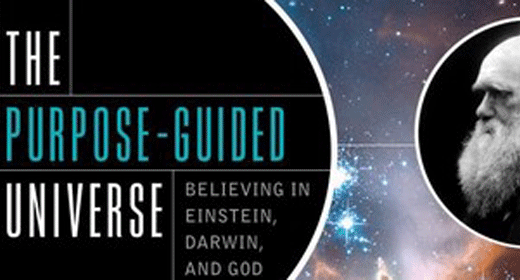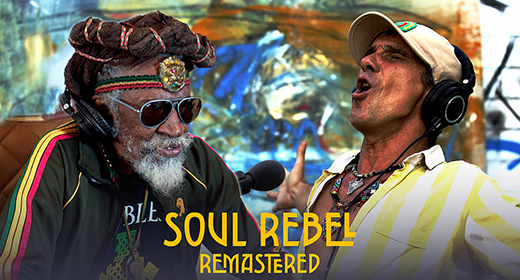byElla Rozett: Holding Two Marys Together…
Mother Mary and Mary Magdalene are particularly close within the holy family that is the ‘communion of saints’ mentioned in the Creed. They were the two women Jesus was closest to in his life: his mother and possibly his closest disciple. Mary Magdalene’s special closeness to Jesus is expressed powerfully in the canonical gospels’ accounts of him appearing first to her alone after his resurrection and sending her as ‘the apostle to the apostles’ (as the Catholic Church calls her) to announce the good news to the others. Her special place in the heart of Jesus is also discussed in apocryphal gospels. In the Gospel of Mary, Levi, one of the disciples, says: “He loved her more than us” (p.18) and Peter says: “Sister, we know that the Savior loved you more than all other women.” (p.10)
Did Jesus therefore want Mary Magdalene to be the sole or top leader of the Church after his ascension, to take his place as the head of the Church? It’s not impossible, but top leadership meant something completely different to him than what it means in our world. As he says in Mark 10:42-44: “…those who are recognized as rulers over the Gentiles lord it over them, and their great ones make their authority over them felt. But it shall not be so among you. Rather, whoever wishes to be great among you will be your servant; whoever wishes to be first among you will be the slave of all.”
So it is conceivable that in Jesus’ mind Mary Magdalene was the head of his Church, but few noticed, because she truly lived his teachings, was “the least among them”, and “did not make her authority felt” in any other way than to love, serve, and uplift all. And that is precisely how she is portrayed in the Gospel of Mary: loving and uplifting all the disciples: “Then Mary arose, embraced them all, (or “tenderly kissed them” as an earlier Greek fragment says)¹ and began to speak … Thus Mary turned their hearts toward the Good.” p.9
Independent of where we fit the two Marys within the hierarchy of Jesus’ communion of saints and keeping in mind that we are called to throw our whole concept of hierarchy out if we want to follow Jesus, we can certainly affirm that both Marys were models of the Christian and the contemplative life. I think it is safe to say, they reached its pinnacle: divine union, or what Catholics call ‘divinization’. That amazing word listed in the subject index of the Catechism of the Catholic Church and explained in article 460 with this quote by Athanasius: “The Son of God became human so that we may become God.” Both Marys have become one with and part of God, an expression of its feminine face. And we are all called to do the same.
Even if we can regard them as two equal expressions of the feminine face of God, our hearts may be drawn differently, at different times, or more strongly to one or the other. That’s okay, because there are different kinds of love. There is the passionate love of a devotee to his or her particular Gate to Heaven, his or her favorite saint or person of the Holy Trinity, and there is the love we are called to have for our entire holy family: our fellow travelers on the Way here below and all the saints in Heaven.
The first, the passionate love of a devotee, is a more exclusive one-on-one thing. The second, the love for our holy family, is a group thing where we are called to be a ‘communion of saints’ as the Creed says, and one mystical body of Christ, as the Bible says.²
To me it is essential to make time and space for both kinds of love. When we pray, it is often good to focus on one object of devotion. And sometimes it is also important to not be stingy with our love and appreciation, but to spread it around to other saints or even other persons of the trinity.
And then yes, sometimes we may sit down to pray and wonder who to turn to. Then it’s time to slow down, listen to our hearts, noticing what our souls want.
Check in with yourself: Do I need the warmth of my divine Mother right now, the cool breeze of the Father, or the support of a particular older brother or sister on the Way? Who wants to come to me right now? Do I feel oppressed by patriarchy (which happens to women and men!) and need someone like Mary Magdalene, who knows what that’s like and isn’t part of it?
It is not so much that we need to choose between the Marys, it’s that sometimes we need to choose between either listening to our minds, our mental habits, or to our hearts and souls, the promptings of the Spirit. Many people have had the experience that it wasn’t them choosing a Mary, but that a Mary (or another saint or archetype) came to them, chose them. Our choice then is between welcoming and consenting or turning away. E.g. the first time a good friend of mine had a vision of Jesus during a meditation with me, she told him: “Sorry, you got the wrong address; I’m Jewish!” She eventually learned to welcome him. Please let’s try to welcome the Spirit, even when it shows up as the deity or preferred saint of a group of people, we consider our adversaries.
Sometimes there are conflicting wants and needs in us. Rather than struggling to decide between them, it’s infinitely easier to take them to prayer. For example, maybe your heart needs a divine mother, but your mind says Mother Mary is a collaborator with a patriarchal Church you’d rather keep a safe distance from. Then just ask her: “What do you have to say for yourself Mary? How do I do this? Please show me the way.” And then listen for a response. Give her and yourself time.
(My opinion on that problem is that yes, the Virgin Mary has been used by the Church to suppress women, just like Jesus has been used to oppress others, but that’s not their fault. They have done their best to challenge existing structures, but it is not their job to undo free will; they can’t force change, they can only call for it and hope someone will hear.)
Another example: maybe your heart needs your sexuality to be embraced and integrated into your spiritual path, but your mind says it’s disrespectful, dirty, historically and politically incorrect to look to Mary Magdalene (and maybe even Jesus) for help with this. Then ask Magdalene (and maybe Jesus): “What do I do? How do I do this? Can you help me?”
When we start to open to a new saint, we may not be immediately ready to put them center stage during any particular prayer time. That’s okay. Maybe invite them to be at your side for now. You can pray with one saint at your side to another.
It is important to know that there is no jealousy or competition among the saints or the persons of the trinity. By praying to one, we automatically receive the blessings and graces of all and all of them are happy. For, as the Catechism of the Catholic Church (article 947) says: “Since all the faithful form one body, the good of each is communicated to the others.”
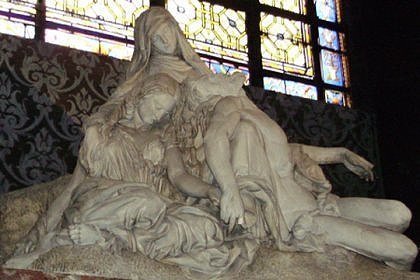
This unusual pieta in the church St. Sulpice in Paris depicts Mary Magdalene as Jesus’ beloved companion and something like a daughter in law of Mother Mary. photo: Ella Rozett
While the French say that Mary Magdalene spent the last 30 years of her life alone in a cave in the Provence, another strong tradition says that after Christ’s resurrection, she lived with Mother Mary and John the Evangelist in Ephesus. So besides being spiritual family, they may have also lived together as family.
To me personally, Mother Mary transmits a vertical energy connecting me to the earth below and to Heaven above, while Mary Magdalene guides me horizontally to opening to the world. Together they cover all directions and fill all dimensions with their grace.
Mary Magdalene in the Bible
Sadly, the story of Mary Magdalene in the Bible needs to start with how much of it was written out. I’m working on an account of this tragedy. Hang on a few more days…. Here’s what I have so far.
A couple of times the Bible lists women, who followed Jesus with his disciples and “provided for them out of their resources”. Both times Mary Magdalene is mentioned first, as if to stress her foremost importance. (see Matthew 27:56, Mark 15:40)
This is where Luke mentions that Jesus freed her from seven demons (Luke 8:2). It has often been assumed that she had therefore been especially sinful or possessed, but don’t we all have at least seven hindrances between us and complete divine union? And couldn’t we therefore shift the emphasis from her being especially sinful to being especially liberated from anything that may have stood between her and God? Then we can see her not as someone still tainted by a shadowy past, but as a woman who was particularly blessed and freed.
Mary Magdalene’s honorary title “the apostle to the apostles” is based on the Gospels of Matthew and John, where Jesus picked her to be the first person to whom he revealed himself after his resurrection and whom he sent to tell the good news to the other disciples.
All four gospels agree (which is rare) that Mary Magdalene was the first person to receive the Good News that Jesus rose from the dead. In Matthew 27:55-28:18 Mary Magdalene and Mary the mother of James and Joseph are the only ones keeping watch at Jesus’ tomb all night. Then they go home for one night, only to return early the next morning, before dawn. An angel greets them at the empty tomb, tells them that Jesus has risen and commands them to run to the disciples and tell them where to meet Jesus. The two Marys are “fearful yet overjoyed”. As they are running to do what they were told, Jesus appears to them. The women “approached, embraced his feet, and did him homage.” (MT 28:9) He repeats the same message the angel had already given them: go and tell the others where to meet me. The other disciples meet Jesus in the designated place, worship him duly, but (unlike the women) they doubt.
Mark 15:40 – 16:13 tells the story similarly at first, but then leaves out the key ingredient: Jesus sending Mary Magdalene to proclaim his resurrection. He also puts more emphasis on the male disciples’ disbelief. They do not believe Mary Magdalene that Jesus rose from the dead, nor do they believe two other men who later report the same thing, nor the Lord himself in his resurrected body.
John mentions Mary Magdalene as standing under the cross with the other two Marys (See article: Mother Mary and the Bible) and gives the most beautiful account of her being the first disciple the risen Jesus appears (Jn 20:11-18). Here she cries so hard that she doesn’t recognize Jesus when he speaks to her until he calls her by her name: “Mary!” Then she immediately exclaims: “Rabbouni!” which means, my teacher, or, my master. Apparently she flings herself at him and wants to hold on to him, because he warns her saying: “Stop holding on to me, for I have not yet ascended to the Father.”
(Others translate simply: “Don’t touch me!”)
Luke’s Gospel is problematic when it comes to Mary Magdalene, because, as Ann Graham Brock shows convincingly in her book “Mary Magdalene, the First Apostle: the Struggle for Authority”, this evangelist does everything he can to bolster the authority of Peter and diminish hers. He leaves out the part where Jesus sends her to proclaim his resurrection, presumably because that would make her not just an Apostle, “one sent by Jesus to proclaim the Good News”, but the Apostle to the Apostles. Instead, he depicts Mary Magdalene receiving the news at the tomb together with a bunch of other women, from “two men in dazzling garments” (24:4). The women take it upon themselves to tell “the eleven and all the others” (24:9); they are not commissioned by Heaven. In Luke’s Gospel, the first mention of any disciples encountering the resurrected Christ is in the story of Jesus’ appearance to two of them on the road to Emmaus. At the end of that, he slips in a little sentence one almost misses: “The Lord has truly been raised and has appeared to Simon!” (24:34) He has no story to back this claim up with, because, it seems, at this point in the sequence of events transmitted to Luke, there was none.
Mary Magdalene in the Apocryphal Gospels
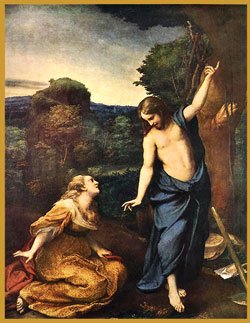
Mary Magdalene and resurrected Jesus, “Noli me Tangere” by Correggio
Apocryphal gospels are those that were not admitted into the Bible. Since they were suppressed, only fragments and damaged copies have been found so far. Words in [square brackets] mark holes in the manuscript that were filled in by scholars’ best guesses. Empty brackets [ ] mean no guesses can be made; too much is missing.
Mary Magdalene figures prominently in “the Gospel of Philip”, “the Gospel of Mary”, and in the “Dialogue of the Savior”. In all three she is presented as his favorite, most enlightened disciple. But that does not at all mean that she is unanimously revered by the disciples. On the contrary, every gospel speaks of conflict surrounding her. The apocryphal gospels are particularly clear that this is because of some of the male disciples’ (particularly Peter’s) jealousy and disrespect for women. Gender conflicts are talked about explicitly. They get patched up temporarily but not really resolved.
So much for Dan Brown and all those people who want to believe that the first Christians were free of such conflict and that the urge to suppress women in general and Mary Magdalene in particular only came later when the Roman Catholic church established itself as an institution of the Roman Empire. Certainly, the Emperor Constantine was no help for women’s liberation, but even while Jesus was alive, most of his male disciples could not follow him in his egalitarian treatment of the other sex.
The canonical (biblical) gospels don’t delve as deeply into the gender conflict, though they mention jealousy and competitiveness even among the male disciples. Concerning the apostles’ feelings about Mary Magdalene, they only mention that the male disciples didn’t believe her that Jesus had risen. But then they don’t believe men either³, and not even Jesus himself. As the Gospel of Matthew says about their encounter with the risen Jesus on the mountain in Galilee, to which he had ordered them: “When they saw him, they worshipped, but they doubted.” (Mt 28:17)
The apocryphal gospels themselves are not unanimously or uniformly pro-feminine. E.g. the Gospel of Thomas ends like this:
“Simon Peter said to him, ‘Mary should leave us, for women are not worthy of the Life.’ Yeshua (Jesus) answered: This is how I will guide her so that she becomes Man. She too, will become a living breath like you Men. Any woman who will make herself a Man will enter into the Kingdom of God.”⁴
Some say that this passage contradicts earlier statements in the Gospel of Thomas and was therefore probably added by a later redactor. They are referring to verse 22: “Yeshua answered them: When you make the two into One, when you make the inner like the outer and the high like the low; when you make male and female into a single One, so that the male is ot male and the female is not female; when you have eyes in your eyes, a hand in your hand, a foot in your foot, and an icon in your icon, then you will enter [the Kingdom].”⁵
“The Dialogue of the Savior”, while granting Mary a place of special honor, also equates “femaleness” with inferiority, worldliness, and obstacles to the spiritual path. It says 144:15-21:
“When we pray, how should we pray? The Lord said, ‘Pray in the place where there is [no] woman.’ Matthew said, ‘He says to us, ‘Pray in the place where there is [no] woman,’ … ‘Destroy [the] works of femaleness,’ not because she is another […], but so that they (the works) will cease [from you].”⁶
The Gospels of Philip and of Mary both recount the jealousy of the male disciples because Jesus loved Mary more than them and revealed things to her that he didn’t reveal to them.
The Gospel of Mary includes an account of what Jesus said to her in a vision. Peter had asked her for this account saying (in 10:1-5): “Sister, we know that the Savior loved you more than the rest of women. Tell us the words of the Savior which you remember – which you know (but) we do not, nor have we heard them.”
But when she finishes:
“Andrew answered and said to the brethren, ‘Say what you (wish to) say about what she has said. I at least do not believe that the Savior said this. For certainly these teachings are strange ideas.’ Peter answered and spoke concerning these same things. He questioned them about the Savior: ‘Did he really speak privately with a woman (and) not openly to us? Are we to turn about and all listen to her? Did he prefer her to us?’ Then Mary wept and said to Peter, ‘My brother Peter, what do you think? Do you think that I thought this up myself in my heart, or that I am lying about the Savior?’ Levi answered and said to Peter, ‘Peter, you have always been hot-tempered. Now I see you contending against the woman like the adversaries. But if the Savior made her worthy, who are you indeed to reject her? Surely the Savior knows her very well. That is why he loved her more than us. Rather let us be ashamed and put on the perfect man, and separate, as he commanded us and preach the gospel, not laying down any other rule or other law beyond what the Savior said.’ When […] and they began to go forth [to] proclaim and to preach.” (17:10-end of gospel)
The Gospel of Philip 63:31-10 states:
“And the companion of the S[avior is] Mary Magdalene … her more than … the disciples … kiss her … on her … The rest of … they said to him, ‘Why do you love her more than all of us?’ The Savior answered them, ‘Why do I not love you like her? When a blind man and one who sees are both together in darkness, they are no different from one another. When the light comes, then he who sees will see the light, and he who is blind will remain in darkness.’ ” — Apparently Mary Magdalene was far more enlightened than the other disciples.
People fill in the gaps in the text according to the context, which suggests that Jesus kissed her on the mouth. They read: “The Savior loved her more than all the disciples and used to kiss her often on her mouth.”
But even if Jesus often kissed her on the mouth, one still cannot assume that they also had sexual intercourse. Four chapters earlier Philip speaks about kissing on the mouth as a ritual act of being born or “begotten” spiritually of Jesus:
“[Those who] are begotten by him [cry out] from that place to the (perfect) man [because they are nourished] on the promise [concerning] the heavenly [place. …] from the mouth, [because if] the word has gone out from that place it would be nourished from the mouth and it would become perfect. For it is by a kiss that the perfect conceive and give birth (to their spiritual selves). For this reason we also kiss one another. We receive conception from the grace which is in each other.” 58:30-59:5
Sounds like they all kissed each other on the mouth. Were they all married to each other? Were they advocating same sex and group marriage?! Of course not. At least during the first five hundred years of Christianity kissing each other on the mouth was part of celebrating the ritual of the Eucharist (or “last supper”) even within the main stream Church. It is refered to in the biography of Mary of Egypt (More on her below). The ancient text describes this extremely chaste and humble hermitess receiving the Eucharist the night before her death: “After the prayer has been spoken, she kisses the priest, as is the custom, on the mouth, receives the holy mysteries and says…” (Gertrude and Thomas Sartory: Maria von Aegypten – Allmacht der Busse, Herder Taschenbuch, 1982, p.55)
It is true that the Gospel of Philip continues for 13 pages to talk about the great mystery of marriage and the original unity of man and woman in the first human (before the female aspect was separated out). It says that: “Christ came to repair the separation which was from the beginning and again unite the two”. (70:15) But it also speaks about the mystery of the “bridal chamber” in a very confusing, obscure, and esoteric way, suggesting that it far exceeds anything an ordinary person would associate with bridal chambers. E.g. in 74:19-20: “He who has been anointed possesses everything. He possesses the resurrection, the light, the cross, the Holy Spirit. The Father gave him this in the bridal chamber;” And in verse 67 it says: “It is from water and fire and light that the son of the bridal chamber (came into being). (…) The Lord [did] everything in a mystery, a baptism and a chrism and a eucharist and a redemption and a bridal chamber.” The Gospel of Thomas 50:15 refers to the “bridal chamber” as the place (this earth) where the bridegroom, Jesus, gets to be with his bride, the disciples.
The gospel of Philip does seem to suggest that Jesus found a deep spiritual union with Mary Magdalene which he deemed extremely important, but which might have been purely spiritual. For he says in 65:30 – 66:5:
“He who comes out of the world can no longer be detained because he was in the world. It is evident that he is above desire and fear. (…) Fear not the flesh, nor love it. If you fear it, it will gain mastery over you. If you love it, it will swallow and paralyze you.” And (76:9): “in the aeon the form of the union is different, although we refer to them by the same names.” (78:30-79:2): “So spirit mingles with spirit, and thought consorts with thought. (…) If you become light, it is the light which will share with you.” (82:4-8) “If there is a hidden quality to the marriage of defilement, how much more is the undefiled marriage a true mystery. It is not fleshly but pure. It belongs not to desire but to the will.”
Some people claim that ‘companion’, the title given to Mary Magdalene in the Gospel of Philip, was an equivalent to ‘wife’. Yet “The Book of Thomas the Contender”, also contained in the Nag Hammadi Library, bestows the same title on Thomas. In 138:6-10 Jesus says: “Now since it has been said that you are my twin and true companion, examine yourself that you may understand who you are, in what way you exist, and how you will come to be.”
It seems to me that if Mary and Jesus were married in the ordinary, “defiled” way (as the Gospel of Philip would call it), the disciples wouldn’t have been so baffled why he would love her more than them and why he would say things to her that he didn’t say to others. Wouldn’t patriarchs love to explain her special status away by saying it grew out of her marriage to Jesus? Isn’t it much more of a challenge to patriarchal thinking to have to acknowledge that she was that special in and of herself and that Jesus appreciated her fully without using her for himself in any way?
Mary Magdalene a Former Prostitute?
Another question we need to discuss is, why did the early Church decide to identify the “sinful woman”, i.e. prostitute, who washed Jesus feet with her tears and covered them with kisses, with Mary Magdalene? There is much evidence that after the ascension of Jesus, there was not only considerable tension between Peter and Paul, but also between Peter and Mary Magdalene. While Mary Magdalene was perhaps his closest disciple, the one who best understood and embodied his teachings and who possibly led the Johannine community,⁷ Peter claimed authority as the founding father of the apostolic lineage of the Catholic Church. Gradually, references to Miriam (Mary Magdalene’s Hebrew name) were literally edited out of the canonical gospels, as the recent work of Elizabeth Schrader⁸ has shown. In one apocryphal book – the Acts of Phillip – her heroic character was completely removed and replaced with Peter in a later re-working of the text.⁹ These developments were happening at the time when Christianity was being adopted as the single official religion of the Roman empire. We can reasonably surmise that Mary Magdalene’s tradition and lineage became seen as politically untenable in a world where patriarchal superiority was the only socially acceptable norm. By falsely labelling and effectively discounting her as a prostitute, the Christian tradition which she led and the gospel in her name became sidelined and buried.
Nowadays many suspect that this happened out of malice, in the attempt to denigrate Mary Magdalene and to topple her from her place of honor. It is true that for millennia men have downplayed or defamed every strong and virtuous woman in the Bible. However, there is a saying that ‘God writes straight with crooked lines’ and I think calling Mary Magdalene a former prostitute served a broader need of men as well as women.
The first problem this solution addresses is that the Bible doesn’t introduce Mary Magdalene properly. Out of nowhere she appears as foremost among the women followers of Jesus and as the one he is closest to after his resurrection. The text mentions in an aside that he healed her from seven demons, but it does not seem to explain why there is this special love between them. So one is naturally left looking for clues to fill in her story and to link her to other stories in the Bible. One such possible clue may be that both the “sinful woman” and Mary kiss his feet and are very passionate in expressing their love. Jesus rewards them both for their free show of devotion. The second clue is that the story of the “sinful woman” in Luke 7: 36-50 is immediately followed by his first mention of Mary Magdalene. In this story Jesus stresses the exemplary love and devotion of the woman and explains it by saying: “many sins have been forgiven her, hence she has shown great love. But the one to whom little is forgiven, loves little.” (Lk 7:47) According to this reasoning it would follow that Mary Magdalene must have sinned much before she found Jesus, because she certainly loved him a lot.
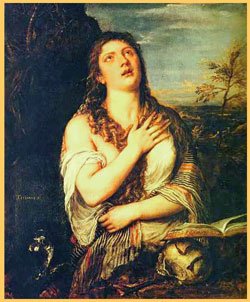
“Penitent St. Mary Magdalene” by Titian
The second problem Magdalene’s characterization as a former prostitute addresses is women’s frustration with the Virgin Mary as the prime example of what a good woman should be like. How many times have I heard Catholic women complain that they had a problem with Mother Mary because she is an impossible example to follow! How can we be expected to be a mother, wife, and virgin?! To be as much like her as possible, women were traditionally admonished to be wives and mothers, yet also “chaste”. That is to say, on the one hand they were not to be sexy, not to want or enjoy sex. On the other hand they were to grant sex to their husbands whenever the men wanted it, as their “marital duty” and their duty to God to procreate. This made many women angry, not at the men, with whom it wasn’t safe to be angry, but with the Virgin Mary, who seemingly put them in this position. Men didn’t appreciate this virgin-wife example either, because it didn’t allow them to have much fun with their own wives.
Then, along comes Mary Magdalene, the former prostitute and a passionate, heroic woman to the end. She may be reformed but at least she knows all about sex. She is never demure, but defiant, free, and self-confident.
Was it not a gift to have a variety of women among the disciples of Christ? Do feminists and Goddess worshippers not profess that one needs to honor the feminine in all its archetypes: as the virgin, the whore, the maiden, mother, and crone? It seems to me that’s what Christians were trying to do. They acknowledge the virgin, mother, prostitute, and crone.
The crone finds supreme expression in the gospels as Elizabeth, Mother Mary’s cousin and the mother of John the Baptist. (To see how important Elizabeth’s spiritual and emotional support was for Mother Mary, read in the article “Mother Mary in the Bible”)
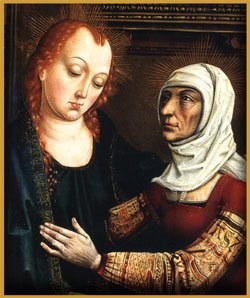
Elizabeth and the Virgin Mary in: “Visitation” by Master of the retablo of the Reyes Catolicos
All these women are in the inner circle of Jesus and nothing bad is ever said about them. Even if Mary Magdalene is identified with the former prostitute, this is never held against her. On the contrary, the Catholic Church sanctified her because she left that way of life and Jesus forgave, loved, honored, and defended her.
It is true that celibate priests tend to focus on the virginal Mary rather than on the passionate Magdalene who knows everything about “down there”. Unfortunately, they cannot freely indulge an issue that is as threatening to them as sexuality. But Christian artists were always happy to take up the cause. Next to the demurely covered virgin, they love to portray a dramatic and sensual Mary Magdalene. Her big, flowing, traditionally red hair has long been a symbol of a Christian’s ability (or at least hope) to make peace with the force of sexuality.
There is one more reason why Mary Magdalene was dubbed “reformed prostitute”: Some time between the 4th and 6th centuries there lived a woman ascetic in the desert of the Holy Land. Her name was Mary of Egypt, and she really was a reformed prostitute from Alexandria who became famous for making a 180 degree turn from extreme lustfulness to extreme holiness, exchanging sexual union with men for divine union with God. She lived 47 years in the desert, naked and practically without food. In the Orthodox Christian world, she is still revered, but in Catholic Christendom her story was gradually melded into the story of Mary Magdalene, the other famous penitent. The two kept getting mixed up with one another, until Mary of Egypt was forgotten, and her story tagged onto Mary Magdalene. Hence the French tradition that Mary Magdalene lived as a hermitess in Sainte Baume, Provence, dressed only in her hair, and fed only by the angels. (See: ibid.: p.12. For more details on Mary of Egypt google her name + catholic or + orthodox)
By the way, referring to someone as a “penitent” does not imply that the person is particularly sinful (as is often assumed by non-Christians). Rather it means they chose an ascetic lifestyle of penance – something all Christians are called to since John the Baptist and Jesus. When they are done purifying their own shortcomings they continue with penances for the sake of the rest of humanity. Like Jesus and his apostles (and like serious practitioners of many other religions) they voluntarily take on what would be hardship to others and use it to transform themselves and others.
Cynthia Bourgeault wrote probably the most balanced book on everything to do with Mary Magdalene. She too sees advantages in Mary Magdalene’s denotation as a penitent prostitute and says: “God sometimes writes straight with crooked lines”.¹⁰
Goddess of Love: Aphrodite, Mary Magdalene or the Virgin Mary?
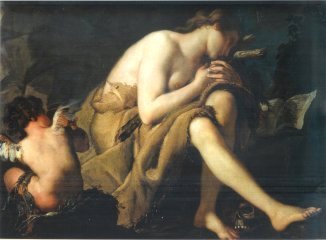
Whatever Magdalene is repentant for, in Christian art it is not for being sensuous. Here she is pressing Jesus on the cross against her naked bosom. “The Penitent Magdalene” by Paolo Pagani (c.1661-1716)
To me Mary Magdalene and Mother Mary are like Isis and her sister Nephtys (Greek) or Nebthet (Egyptian). Isis was more famous, more important, more powerful. But she had a sister who was her complementary opposite. Isis was the day, life, fertility; Nephtys the night, death, barrenness. Yet they decided to work together for the greater good and gradually Isis incorporated all the attributes of her sister.
Similarly, the Virgin Mary has this spiritual sister Magdalene. One is purity, virginity, obedience, silent humility. The other is passion, sexuality, loudly outrageous and shamelessly non-conforming. Once the virgin and the whore Mary were paired up as a suitable couple of sisters in the Spirit, the Virgin started to claim her sexuality and the whore her saintliness.¹¹
In medieval art and thinking Mother Mary had to fulfill all the old roles of the goddesses. That meant she was responsible for everything to do with a woman’s life: love, passion, fertility, childbearing, praying, and dying.
Mother Mary’s role as the Christian goddess of love was expressed in three symbols: the red rose, the unicorn, and the color red.
1. Since ancient times the red rose was a symbol of the goddess Venus and erotic love. The vagina was often referred to as ‘the little rose beneath the rosebush’. In the Middle Ages, with its troubadours spreading a culture of refined and spiritual love and with the crusaders emphasizing self-sacrificial love, the rose conquered the imagination of European Christians. It became one of the favorite symbols of human and divine, romantic and spiritual love. Mother Mary became known as the ‘mystical rose’ and her chaplet of prayers as the ‘rosary’, a collection of roses. To this day it is said that each time someone prays the rosary, Mary is crowned with a fresh crown of roses, i.e. with the power of love and femininity.
2. Mary and the unicorn were often portrayed in an enclosed garden. According to myth only a pure virgin (the enclosed garden symbolized her virginal womb)¹²
could capture a unicorn. The powerfully good, yet fiercely wild animal could not be killed by hunters unless it came across a pure virgin. Then it would lay its head in her lap and fall asleep. At that point its pursuers would strike.
In the Christian context this story came to mean that the fierce, male God could only be bound in this world, tamed, and made docile by the exceedingly pure and docile Virgin Mary. Once he entered her womb and became Jesus Christ he could be sacrificed as the Lamb of God for the good of all.

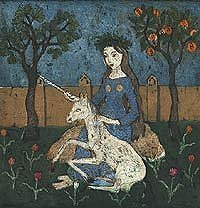
But the unicorn also retained its worldly aspect. It represented wild, ferocious manhood that could only be tamed by pure womanhood and would gladly allow itself to be trapped into holy matrimony and made docile. In that context the Virgin Mary represented virtuous womanhood taming wild manhood and channeling erotic passion into the ‘sacrament of marriage’.¹³
3. Mother Mary’s passionate love also came to be represented by the red robes under her blue mantel. Apparently people felt so justified in their sexual passions by Mary’s red robes that during the Renaissance the church decided to put an end to Mother Mary as the goddess of love. Suddenly she was not allowed to be portrayed in red anymore, and no more unicorns either. In 1563, the Council of Trent condemned all associations of the Virgin Mary with the unicorn and henceforth only virginal white veils and heavenly blue mantels were permitted.
That’s when the two Marys, who had become one, were separated out again and the responsibility of holding a space for human sexuality fell solely onto the beautiful, naked shoulders and the red open hair of Mary Magdalene.
I like the two aspects in one figure, and I find the Virgin Mary to be quite efficacious in blessing the sexual union of husband and wife with a cosmic passion. Unfortunately, we don’t have a goddess of human love in Christianity. We miss the Aphrodite archetype. The closest we can come to it is in the idea of the good prostitute, which in a Christian context can only mean a former, repentant prostitute, a sensuous, passionate saint like Mary Magdalene.
I agree that ‘Aphrodite’ is a much nicer name for the archetype ‘goddess of love’ than ‘repentant prostitute’. But since Aphrodite is a Greek goddess, we may just have to realize that Mary Magdalene is the Christian form of Aphrodite, the same archetype by a different name.
Dan Brown’s “The Da Vinci Code”
Though I was not impressed with the book, I loved the movie.
Certainly, if Jesus had married, it would have been Mary Magdalene. In the Bible as well as in art, she is consistently portrayed as his closest female disciple, a very intimate one with definite romantic overtones. Many depictions of the crucifixion show her wrapped around the cross of Christ in such a physically intimate way that the message can’t be overlooked: Jesus and Mary Magdalene were somehow a couple.
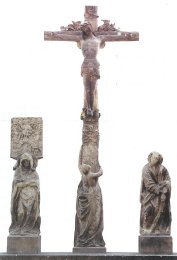
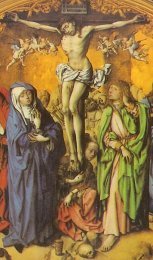
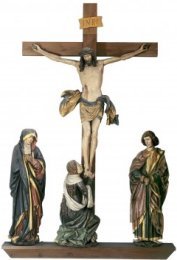
Jewish custom did indeed dictate that a Rabbi had to be married and Jesus was called Rabbi on several occasions. But Jewish custom also said that once a man was married, he was not to speak to any women besides his wife and immediate family. Jesus, on the other hand, made a point of talking to many women and of not worrying too much about laws and customs. We know for sure that the apostle Paul was not married and even so, contrary to Jewish custom, did teach in synagogues. We also know that both, being married and being celibate were completely acceptable options for leaders in the early church.
Hence, we may never know for sure if Jesus was married to Mary Magdalene and if they had children, but I don’t think it makes nearly as much of a difference as Dan Brown suggests. Jesus’ message doesn’t hinge on that. But there certainly is a lot more evidence that Jesus was celibate than that he was married. To give only one example: in Matthew 19:11-12 Jesus says that forsaking marriage for the sake of the kingdom of God is a mystery many practice, but many others with inferior capacities cannot grasp.
Even if Jesus had children, they wouldn’t necessarily have been important. As he says in Mat 13:50, and in the other gospels: those who do the will of his heavenly father are his family. Certainly his apostles must have had children, but they are never mentioned anywhere. Remember, we are talking about religion here, and about the kingdom of God, not about worldly royal bloodlines and kingdoms who usually ended up with imbeciles because of inbreeding.
Other religious founders had children who played no important role in history. Buddha’s son wasn’t particularly special and died at an early age. In Islam only the Shiite minority took Mohammed’s bloodline into account when determining its leadership. Judaism certainly venerates its bloodline of patriarchs, yet the prophets whom God established as the spiritual leaders were independent of any bloodline. Lord Krishna, the Hindu god of love, must have had thousands of children because he is said to have had 16,000 queens, plus consorts! Yet I’ve never heard his children mentioned anywhere. Historically, only the leadership of the Bahai was passed from father to son. So it seems that spiritual enlightenment does not normally transfer with the DNA.
But if you’re looking for divinity in someone’s DNA, that’s an easy find, because we’re all created by God and in God’s image by receiving His breath, i.e. spirit. Hence, it seems to me that the whole human race is of God’s bloodline.
Concerning the supposed motivation (according to “The Da Vinci Code”) for concealing Jesus’ marriage: Dan Brown says that it was the Catholic Church’s effort to portray Jesus as purely divine and not human. Actually, the Church insisted from the start that Jesus was both human and divine.
It argued against the Gnostics who would take away from Jesus’ humanness by saying that he didn’t really suffer on the cross, because God doesn’t suffer. It also argued against those who would diminish his divinity by teaching that Jesus started out as an ordinary human and only later became the Son of God.
Only it wasn’t until the council of Ephesus (431 C.E.) that the Church could agree precisely how divine and how human Jesus Christ was at any given point in time, and how those “two natures” co-exist.
In my opinion the “two natures of Christ” are the very core and gem of Christianity. It is rare to find another religion that gives us permission to be, like Jesus, truly human and truly divine. Mystical Christianity does.
Rather than hurting the veneration of the “divine feminine”, insisting that Jesus was “truly human and truly divine” from the moment of his conception, actually gave it a great boost. For it justified the veneration of the Virgin Mary as Mother of God.
What is certainly true is that at a certain point the Church started suppressing anything that supported women’s full participation in the Church. But that sharing of ministry and power did not depend on the supposed descendants of Mary Magdalene and Jesus. Rather it would have been quite sufficient to faithfully emulate Jesus and Paul (on a good day!). But instead, Jesus’ own relationship with the many women in his life was ignored and to Paul’s true letters, fake, misogynistic ones were added. (see: my article on “Women of Spirit and Power in the Bible”, especially the section “the Woman who Anointed Jesus”)
And the Holy Grail? In the movie it is described as “the source of God’s power on earth”. – If Jesus is God’s power on earth then Mary, his mother, could be seen as his source. Indeed, to me much of what the movie says about Mary Magdalene is more true about the Virgin Mary. Loius Charpentier in his book “Les Mysteres de la Cathedrale de Chartres” explains that the Knights Templar went to Jerusalem, not to seek the Holy Grail, but the Ark of the Covenant, which they hoped to find in the ruins of the Temple of Solomon. Charpentier says, that they certainly did find an esoteric knowledge and a source of power and wealth that enabled them suddenly to create gothic cathedrals. Maybe so, but along with that knowledge they found Black Madonnas (see my article) and they venerated their Dark Mothers in those cathedrals.
From of old Mother Mary was given the title “Ark of the Covenant”, because she was the vessel of the New Covenant: Jesus Christ. To her the Templars dedicated their order, their cathedrals, and their hearts.
Mary Magdalene Pilgrimage Sites
1. Ephesus: Donald Carroll states the following in his book “Mary’s House: The extraordinary story behind the discovery of the house where the Virgin Mary lived and died” on pages 78-80: “In 1952 a large sarcophagus was unearthed near the entrance of a grotto on the outskirts of Ephesus known as the Cave of the Seven Sleepers, so-called because of an ancient Christian legend attached to it. The sarcophagus was positively identified by Professor Louis Massignon of the College de France as the tomb of Mary Magdalene. The bones were removed and are now in the Church of St. Mary Magdalene in Paris. (Read more about Mary’s house in Ephesus in the “Mother Mary and the Goddess” article.)
2. So Paris is interesting both because of the Church of St. Mary Magdalene and because of the sanctuary and apparition site of Our Lady of the Miraculous Medal in the Rue du Bac. The shell of Magdalene’s church (L’eglise de Sainte Madeleine) is a very big reproduction of a Greek temple that has long housed what is claimed to be the thigh bone of Mary Magdalene, but which did not come from the excavations in Ephesus. When I was there in 2006 I did not find any other remains of Magdalene and the local custodian assured me there are no others kept at the church. Later I found out though that the church has a crypt (which I didn’t see). Who knows what they are hiding down there!
3. Sainte-Baume is a beautiful place in Southern France, where the Magdalene is said to have spent the last 30 years of her life as a hermit. There is other evidence that she lived with Mother Mary and John in their home in Ephesus after the crucifixion of Christ. However, it is conceivable that she also traveled to France. After all Jesus had urged his apostles and disciples to emulate his wandering as a homeless beggar. In any case, a site where a saint has been honored and invoked for roughly a thousand years is sure to be filled with her blessing presence. To this day there is a lived tradition of devotion to Mary Magdalene at Sainte-Baume, and, as an exhibit in the Dominican monastery that guards her shrine states, the enchanting woods leading to her cave-hermitage were already regarded as a sacred goddess site in pre-Christian times.






